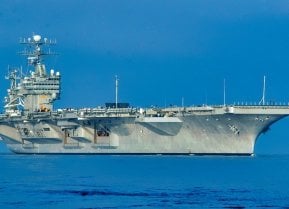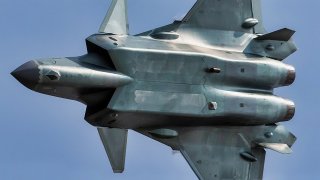J-20: A Chinese Air Force Pilot Tells Us What Flying A Stealth Fighter Is Like
The Pentagon should now plan for scenarios where an F-22 or F-35 would get in a dogfight with the J-20 in a potential conflict with China. The Mighty Dragon is a reality, and more are on the way.
Roughly a year ago, a pilot from China who has flown at least three different fighter planes has revealed he is learning from his flights in a J-10 to be able to operate a stealth fifth-generation Chengdu J-20 Mighty Dragon.
Chen Liu, who is seemingly one of China’s best pilots judging from his record with other airplanes, told state-run media in a recent interview that the J-20 can sometimes be a handful due to its robust weapon systems.
Still, overall, his review of the Mighty Dragon is positive with few complaints. The J-20 is China’s version of the American F-35 or F-22 and is lauded as Beijing’s best fighter.
China Is Going Public With J-20 Flight
The EurAsian Times translated an interview with Chen from CCTV that was posted on YouTube several months back. Aside from dealing with munitions, he said the avionics of the newer J-20 makes it easier to fly than the J-10. The J-10 is a fourth-generation People’s Liberation Army Air Force (PLAAF) fighter whose origins date back to 1988. It entered service in 2004. The J-10 is considered the “backbone” of the PLAAF.
J-20 Pilots Must Rapidly Deal with Incoming Data
Chen mentioned that the J-20 can vacuum up a “vast amount of data – something similar to the F-35 – which is then processed before being relayed to the pilot.” He stated that the J-10’s single-seat configuration prepared him well for the single-seat of the J-20 since pilots are expected to quickly process all the information that is displayed in the cockpit of the latest warplane.
No Flight Problems Except for Challenging Operations of Weapons
Chen said that he “had no problems when he first began flying the J-20, he mentioned that the aircraft is difficult to master because of its sophisticated weapon system.” The munitions in the J-20 are in internal weapons bays and they are believed to carry “four to six long-range missiles or bombs,” according to the National Interest. The defense magazine goes on to describe the multi-mission role of the J-20, “observers mostly speculate the J-20 would either serve as long-range supersonic strike plane, or a hit-and-run interceptor used to slip past fighter screens and take out vulnerable supporting tanker and AWACS planes.”
They’re Making Them Fast
If other PLAAF pilots are having similar success flying the J-20 this bodes well for China. The country may have as many as 150 J-20s in service and the manufacturing lines are still running. The PLAAF may be getting one J-20 every month, and these are similar in capability to American F-35 and F-22 fifth-generation fighters. This is because China likely stole design plans from the United States.

The J-20 can speed along at almost MACH 2, and it has a ceiling of around 60,000 feet with a range of 1,200 to 2,000 miles (we note that range estimates are varied based on sourcing).
Time to Deal with the Reality of the J-20
Interestingly, the PLAAF is willing to let a pilot be interviewed in a national media outlet about the J-20, which China is usually tight-lipped about. This means the PLAAF has confidence in the program and is happy to see the United States and its East Asian allies sweat about the J-20 capabilities.

It’s time for the U.S. military to quit squawking about stolen designs. What’s done is done. The Pentagon should now plan for potential scenarios in which an F-22 or F-35 would get in a dogfight with the J-20 in a potential conflict with China. The Mighty Dragon is a reality, and more are on the way.
About the Author
Dr. Brent M. Eastwood is the author of Humans, Machines, and Data: Future Trends in Warfare. He is an Emerging Threats expert and former U.S. Army Infantry officer. You can follow him on Twitter @BMEastwood. He holds a Ph.D. in Political Science and Foreign Policy/ International Relations.
All images are Creative Commons.


